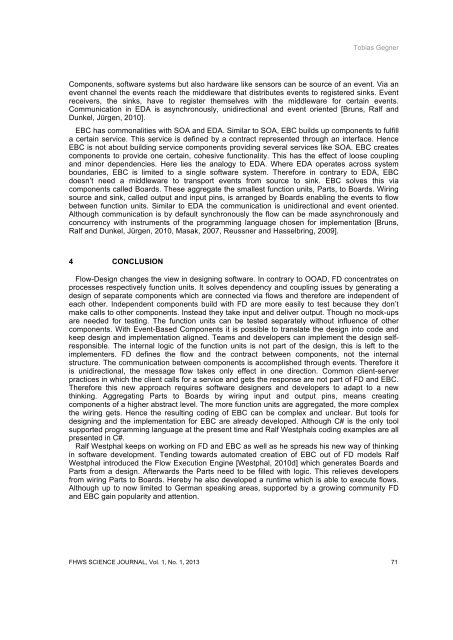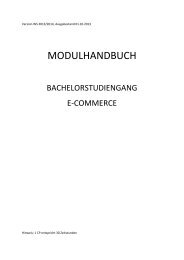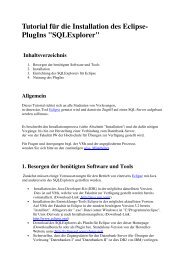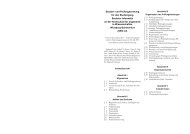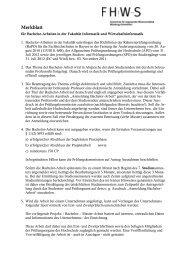FHWS Science Journal - Fakultät Informatik und Wirtschaftsinformatik
FHWS Science Journal - Fakultät Informatik und Wirtschaftsinformatik
FHWS Science Journal - Fakultät Informatik und Wirtschaftsinformatik
Create successful ePaper yourself
Turn your PDF publications into a flip-book with our unique Google optimized e-Paper software.
Tobias Gegner<br />
Components, software systems but also hardware like sensors can be source of an event. Via an<br />
event channel the events reach the middleware that distributes events to registered sinks. Event<br />
receivers, the sinks, have to register themselves with the middleware for certain events.<br />
Communication in EDA is asynchronously, unidirectional and event oriented [Bruns, Ralf and<br />
Dunkel, Jürgen, 2010].<br />
EBC has commonalities with SOA and EDA. Similar to SOA, EBC builds up components to fulfill<br />
a certain service. This service is defined by a contract represented through an interface. Hence<br />
EBC is not about building service components providing several services like SOA. EBC creates<br />
components to provide one certain, cohesive functionality. This has the effect of loose coupling<br />
and minor dependencies. Here lies the analogy to EDA. Where EDA operates across system<br />
bo<strong>und</strong>aries, EBC is limited to a single software system. Therefore in contrary to EDA, EBC<br />
doesn’t need a middleware to transport events from source to sink. EBC solves this via<br />
components called Boards. These aggregate the smallest function units, Parts, to Boards. Wiring<br />
source and sink, called output and input pins, is arranged by Boards enabling the events to flow<br />
between function units. Similar to EDA the communication is unidirectional and event oriented.<br />
Although communication is by default synchronously the flow can be made asynchronously and<br />
concurrency with instruments of the programming language chosen for implementation [Bruns,<br />
Ralf and Dunkel, Jürgen, 2010, Masak, 2007, Reussner and Hasselbring, 2009].<br />
4 CONCLUSION<br />
Flow-Design changes the view in designing software. In contrary to OOAD, FD concentrates on<br />
processes respectively function units. It solves dependency and coupling issues by generating a<br />
design of separate components which are connected via flows and therefore are independent of<br />
each other. Independent components build with FD are more easily to test because they don’t<br />
make calls to other components. Instead they take input and deliver output. Though no mock-ups<br />
are needed for testing. The function units can be tested separately without influence of other<br />
components. With Event-Based Components it is possible to translate the design into code and<br />
keep design and implementation aligned. Teams and developers can implement the design selfresponsible.<br />
The internal logic of the function units is not part of the design, this is left to the<br />
implementers. FD defines the flow and the contract between components, not the internal<br />
structure. The communication between components is accomplished through events. Therefore it<br />
is unidirectional, the message flow takes only effect in one direction. Common client-server<br />
practices in which the client calls for a service and gets the response are not part of FD and EBC.<br />
Therefore this new approach requires software designers and developers to adapt to a new<br />
thinking. Aggregating Parts to Boards by wiring input and output pins, means creating<br />
components of a higher abstract level. The more function units are aggregated, the more complex<br />
the wiring gets. Hence the resulting coding of EBC can be complex and unclear. But tools for<br />
designing and the implementation for EBC are already developed. Although C# is the only tool<br />
supported programming language at the present time and Ralf Westphals coding examples are all<br />
presented in C#.<br />
Ralf Westphal keeps on working on FD and EBC as well as he spreads his new way of thinking<br />
in software development. Tending towards automated creation of EBC out of FD models Ralf<br />
Westphal introduced the Flow Execution Engine [Westphal, 2010d] which generates Boards and<br />
Parts from a design. Afterwards the Parts need to be filled with logic. This relieves developers<br />
from wiring Parts to Boards. Hereby he also developed a runtime which is able to execute flows.<br />
Although up to now limited to German speaking areas, supported by a growing community FD<br />
and EBC gain popularity and attention.<br />
<strong>FHWS</strong> SCIENCE JOURNAL, Vol. 1, No. 1, 2013 71


